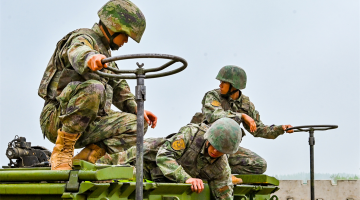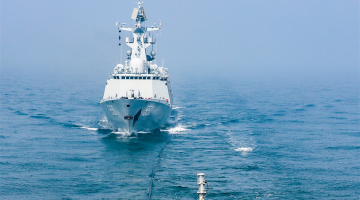
The picture shows that a fleet formed by the US B-2 stealth bombers and the British F-35 fighter jets flies over the Strait of Dover.
On August 27, the United States European Command (EUCOM) announced that the US Air Force deployed three B-2 stealth bombers with the capability of carrying nuclear weapons to the Royal Air Force(RAF) Fairford in Gloucestershire of southwest England. The deployment used RAF Fairford as the “forefront operational base” in Europe to deter “potential opponents”.
Only three days after the deployment, the US B-2 stealth bombers and the UK F-35B stealth fighter jets conducted the first joint cruising flight over the Strait of Dover. This is the first coordinated training between the US B-2 stealth bombers and non-US F-35 fighter jets.
From the public photos of the US Air Force, it can be seen that the joint formation consists of two B-2 stealth bombers ($2.1 billion each) and two F-35B fighter jets ($120 million each), totaling over $4.4 billion. It is also reported that in addition to the joint cruise, the US-British joint stealth fighter formations also carried out aerial refueling and coordinated combat drills.
Judging from the current situation, the US and the UK mainly have the following three considerations for issuing the joint training in a high-profile way.
Firstly, to show the "unbreakable" ally relations between the US and the UK.
Since taking office, President Donald Trump has repeatedly said that the US has paid too much and its allies have given too little feedback in their alliance relations.President Trump has repeatedly "poured cold water" on the US-UK alliance, and urged the UK to increase its defense budget and make more contributions to NATO's collective defense, which made the US-UK relationship fall to its lowest level ever.
At present, under the background of the crucial Brexit decisive battle, the UK needs more understanding and support from the US, while the US also needs to demonstrate the "special status" of Britain in its foreign relations through "intimate actions." Therefore, the announcement of the joint training was just to make the above intentions public in a subtler way.
Secondly, to strengthen the strategic deterrence capability against Russia.
Recently, with the official withdrawal of the US from the Intermediate-Range Nuclear Forces (INF) Treaty and the launch tests of land-based cruise missiles, the US-Russia relations have shown signs of further deterioration. The European region, as the forefront base for the US-Russia confrontation, bears the brunt and faces a more severe security situation.
The B-2 stealth bomber contingent deployed by the US military in the UK only has offensive but no defense capabilities. The main purpose therefore is obviously not " to contain the enemy's aggression against its allies and partners", as suggested in the official propaganda.
Judging from the actual situation, the joint training is more about a display of the US-UK strong long-range offensive capabilities to Russia, to show the US' "defense commitment" to its European allies and send a strong deterrent signal to Russia.
Thirdly, to warn Iran of possible wars.
Since the US’ withdrawal from the Iranian nuclear deal, US-Iran relations have continued to deteriorate. With the increasing "maximum pressure" imposed by the US and Iran's frequent counter-measures since May this year, the US-Iran strategic game has turned white-hot.
From a tactical perspective, the joint cruising mission over the Strait of Dover carried out by the US B-2 stealth bombers and the British F-35 fighter jets was meant to get their troops trained for the US-led Persian Gulf patrols.
National Interest magazine in the US recently published an article on its website, saying that the US military is most likely to launch aerial military operations against Iran in the future. The F-22 stealth fighter jets will make the first "kick", and its air striking forces including the B-2 stealth bombers and F-35 fighter jets will follow to deliver a "finishing stroke", in an effort to jointly put pressure on Iran. Therefore, the US-UK joint training can also be interpreted as a "rehearsal" of the future military operations against Iran.
The regional situation tends to worsen
Against the backdrop of the continued tension in US-Russia relations and the escalating US-Iran strategic game, the US will further strengthen its deployment of military forces to the UK in the future, and also boost its strategic strike capability as well as military reserve in Europe.
According to the deployment plan, the US military has scheduled to permanently deploy F-35 fighter jets at RAF Lakenheath in Suffolk in 2021 to "strengthen the combat capability between the US and its F-35 project allies", in addition to deploying B-2 stealth bombers to the UK.
It is foreseeable that the US military will further strengthen real combat training with its allies, including the UK in the future, and promote its integrated combat capabilities, especially the construction of long-range precision strike capabilities, ensuring that the UK air combat forces grow to be the forefront forces to strategically deter Russia and the reserve army to launch military operations against Iran.
The US practices are not conducive to maintaining the strategic stability of the European region and effectively solving the dilemma of the Iranian nuclear issue. In the context of the over-increasing pressure put by the US, Russia is bound to further strengthen its military deployment to Europe, and carry out targeted exercises and training, as well as the research and development of cutting-edge weapons. The failure of the INF Treaty is to lead to continued deterioration in the European security situation. On the other hand, it is difficult for Iran to succumb to US military hegemony and economic sanctions in the future, and it is bound to take more radical countermeasures. The security situation in the Persian Gulf region is still not optimistic.









